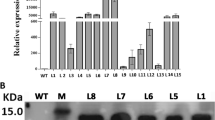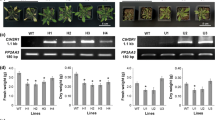Abstract
The barley genesHvLtp4.2 andHvLtp4.3 both encode the lipid transfer protein LTP4 and are less than 1 kb apart in tail-to-tail orientation. They differ in their non-coding regions from each other and from the gene corresponding to a previously reportedLtp4 cDNA (nowLtp4.1). Southern blot analysis indicated the existence of three or moreLtp4 genes per haploid genome and showed considerable polymorphism among barley cultivars. We have investigated the transient expression of genesHvLtp4.2 andHvLtp4.3 following transformation by particle bombardment, using promoter fusions to theβ-glucuronidase reporter sequence. In leaves, activities of the two promoters were of the same order as those of the sucrose synthase (Ss1) and cauliflower mosaic virus 35S promoters used as controls. Their expression patterns were similar, except thatLtp4.2 was more active thanLtp4.3 in endosperm, andLtp4.3 was active in roots, whileLtp4.2 was not. The promoters of both genes were induced by low temperature, both in winter and spring barley cultivars. Northern blot analysis, using theLtp4-specific probe, indicated thatXanthomonas campestris pv.translucens induced an increase over basal levels ofLtp4 mRNA, whilePseudomonas syringae pv.japonica caused a decrease. TheLtp4.3-Gus promoter fusion also responded in opposite ways to these two compatible bacterial pathogens, whereas theLtp4.2-Gus construction did not respond to infection.
Similar content being viewed by others
References
Arondel V, Kader J-C (1990) Lipid transfer proteins in plants. Experientia 46:579–585
Callis J, Fromm M, Walbot W (1987) Introns increase gene expression in cultured maize cells. Genes Dev 1:1183–1200
Christensen AH, Sharrock RA, Quail PH (1992) Maize polyubiquitin genes: structure, thermal perturbation of expression and transcript splicing, and promoter activity following transfer to protoplasts by electroporation. Plant Mol Biol 18:675–689
Church GM, Gilbert W (1984) Genomic sequencing. Proc Natl Acad Sci USA 81:1991–1995
Cramer CL, Edwards K, Dron M, Liang X, Dildine SL, Bolwell GP, Dixon RA, Lamb CJ (1989) Phenylalanine ammonia-lyase gene organization and structure. Plant Mol Biol 12:367–383
Després C, Subramaniam R, Matton DP, Brisson N (1995) The activation of the potatoPR-10a gene requires the phosphorylation of the nuclear factor PBF-1. Plant Cell 7:589–598
Díaz I, Carbonero P (1992) Isolation of protoplasts from developing barley endosperm: a tool for transient expression studies. Plant Cell Rep 10:595–598
Díaz I, Royo J, Carbonero P (1993) The promoter of barley trypsin-inhibitor BTI-CMe, discriminates between wheat and barley endosperm protoplasts in transient expression assays. Plant Cell Rep 12:698–701
Díaz I, Royo J, Sánchez de la Hoz P, Carbonero P (1995) Gene specificity is maintained in transient expression assays with protoplasts derived from different tissues of barley. Euphytica 85:203–207
Dunn MA, Hughes MA, Zhang L, Pearce RS, Quigley AS, Jack PL (1991) Nucleotide sequence and molecular analysis of the low temperature induced cereal gene, BLT4. Mol Gen Genet 229:389–394
Dunn MA, Goddard NJ, Zhang L, Pearce RS, Hughes MA (1994) Low-temperature-responsive genes have different control mechanisms. Plant Mol Biol 24:879–888
García-Olmedo F, Molina A, Segura A, Moreno M (1995) The defensive role of nonspecific lipid-transfer proteins in plants. Trends Microbiol 3:72–74
García-Olmedo F, Molina A, Segura A, Moreno M, Castagnaro A, Titarenko E, Rodríguez-Palenzuela P, Piñciro M, Díaz I (1996) Engineering plants against pathogens: a general strategy. Field Crop Res, in press
Gausing K (1994) Lipid transfer protein genes specifically expressed in barley leaves and coleoptiles. Planta 192:574–580
Guiltinan MJ, Marcotte WR, Quatrano RS (1990) A plant leucine zipper protein that recognizes an abscisic acid response element. Science 250:267–271
Hattoni M, Sakaki Y (1986) Dideoxy sequencing method using denatured plasmid templates. Anal Biochem 152:232–238
Hendriks T, Meijer EA, Thoma S, Kader J-C, de Vries SC (1994) The carrot extracellular lipid transfer protein EP2: quantitative aspects with respect to its putative role in cutin synthesis. In: Coruzzi G, Puigdomènech P (eds) Plant Molecular Biology: NATO ASI Series vol H81. Springer-Verlag, Berlin-Heidelberg, pp 85–94
Hughes MA, Dunn MA, Pearce RS, White AJ, Zhang L (1992) An abscisic-acid-responsive, low temperature barley gene has homology with a maize phospholipid transfer protein. Plant Cell Environ 15:861–865
Jakobek JL, Smith JA, Lindgren PB (1993) Suppression of bean defense responses byPseudomonas syringae. Plant Cell 5:57–63
Jefferson RA (1987) Assaying chimeric genes in plants: the GUS gene fusion system. Plant Mol Biol Rep 5:387–405
Kahn TL, Fender SE, Bray EA, O'Conell MA (1993) Characterization of expression of drought and abscisic acid-regulated tomato genes in the drought-resistant speciesLycopersicon pennellii. Plant Physiol 103:597–605
Lagrimini LM, Burkhart W, Moyer M, Rothstein S (1987) Molecular cloning of complementary DNA encoding the lignin-forming peroxidase from tobacco: molecular analysis and tissue-specific expression. Proc Natl Acad Sci USA 84: 7542–7546
Linnestad C, Lönneborg A, Kalla R, Olsen O-A (1991) Promoter of a lipid transfer protein gene expressed in barley aleurone cells contains similarmyb andmyc recognition sites as the maizeBz-McC allele. Plant Physiol 97: 841–843
Loake GJ, Faktor O, Lamb CJ, Dixon RA (1992) Combination of H-box [CCTACC(N)7CT] and G-box (CACGTG) cis elements is necessary for feed-forward stimulation of a chalcone synthase promoter by the phenylpropanoid-pathway intermediatep-coumaric acid. Proc Natl Acad Sci USA 89: 9230–9234
Lois R, Dietrich A, Hahlbrock K, Schulz W (1989) A phenylalanine ammonia-lyase gene from parsley: structure, regulation and identification of elicitor and light responsive cis-acting elements. EMBO J 8: 1641–1648
Maraña C, García-Olmedo F, Carbonero P (1990) Differential expression of two types of surcose synthase-encoding genes in wheat in response to anaerobiosis, cold shock and light. Gene 88: 167–172
Meijer EA, de Vries SC, Sterk P, Gadella DWJ, Wirtz KWA, Hendriks T (1993) Characterization of the non-specific lipid transfer protein EP2 from carrot (Daucus carota L.). Mol Cell Biochem 123: 159–166
Molina A, García-Olmedo F (1991) Patent application P9101258 (24.05.91) PCT/EP92/01130. US Patent Number 5,446,127 (29.08.95).
Molina A, García-Olmedo F (1993) Developmental and pathogen-induced expression of three barley genes encoding lipid transfer proteins. Plant J 4: 983–991
Molina A, García-Olmedo F (1994) Expression of genes encoding thionins and lipid-transfer proteins. A combinatorial model for the responses of defense genes to pathogens. In: Coruzzi G, Puigdomènech P (eds) Plant Molecular Biology: NATO ASI Series vol H81. Springer-Verlag, Berlin-Heidelberg, pp 235–244
Molina A, Segura A, García-Olmedo F (1993) Lipid transfer proteins (nsLTPs) from barley and maize leaves are potent inhibitors of bacterial and fungal plant pathogens. FEBS Lett 316: 119–122
Moreno A, Segura A, García-Olmedo F (1994) Pseudothionin-St1, a potato peptide active against potato pathogens. Eur J Biochem 223: 135–139
Mundy J, Rogers JC (1986) Selective expression of a probable amylase/protease inhibitor in barley aleurone cells: comparasion to the barley amylase/subtilisin inhibitor. Planta 169: 51–63
Ohl S, Hedrick SA, Chory J, Lamb CJ (1990) Functional properties of a phenylalanine ammonia-lyase promoter fromArabidopsis. Plant Cell 2: 837–848
Plant AL, Cohen A, Moses MS, Bray EA (1991) Nucleotide sequence and spatial expression pattern of a drought- and abscisic acid-induced gene of tomato. Plant Physiol 97: 900–906
Prestridge DS (1991) SIGNAL SCAN: a computer program that scans DNA sequences for eukaryotic transcriptional elements. CABIOS 7: 203–206
Pyee J, Yu H, Kolattukudy PE (1994) Identification of a lipid transfer protein as the major protein in the surface wax of broccoli (Brassica oleracea) leaves. Arch Biochem Biophys 311: 460–468
Sambrook J, Fritsch EF, Maniatis T (1989) Molecular cloning: a laboratory manual (2nd edn). Cold Spring Harbor Laboratory Press, Cold Spring Harbor, New York
Schindler V, Menkens AE, Beckmann H, Ecker JR, Cashmore AR (1992) Heterodimerization between light-regulated and ubiquitously expressedArabidopsis GBF bZIP proteins. EMBO J 11: 1261–1273
Segura A, Moreno M, García-Olmedo F (1993) Purification and antipathogenic activity of lipid transfer proteins (LTPs) from leaves ofArabidopsis and spinach. FEBS Lett 332: 243–246
Skriver K, Leah R, Müller-Uri F, Olsen F-L, Mundy J (1992) Structure and expression of the barley lipid transfer protein geneLtp1. Plant Mol Biol 18: 585–589
Sterk P, Booij H, Schellekens GA, Van Kammen A, de Vries SC (1991) Cell-specific expression of the carrotEP2 lipid transfer protein gene. Plant Cell 3: 907–921
Taylor B, Powell A (1982) Isolation of plant DNA and RNA. Focus 4: 4–5
Taylor MG, Vasil IK (1991) Histology of, and physical factors affecting, transient GUS expression in pearl millet (Pennisetum glaucum (L.) R.Br.) embryos following microprojectile bombardment. Plant Cell Rep 10: 120–125
Terras FRG, Goderis IJ, Van Leuven F, Vanderleyden J, Cammue BPA, Broekaert WF (1992) In vitro antifungal activity of a radish (Raphanus sativus L.) seed protein homologous to nonspecific lipid transfer proteins. Plant Physiol 100: 1055–1058
Thoma S, Kaneko Y, Somerville C (1993) A non-specific lipid transfer protein fromArabidopsis is a cell wall protein. Plant J 3: 427–436
Thompson JD, Higgins DG, Gibson TJ (1994) CLUSTAL W: improving the sensitivity of progressive multiple sequence alignment through sequence weighting, position-specific gap penalties and weight matrix choice. Nucleic Acids Research 22: 4673–4680
Torres-Schumann S, Godoy JA, Pintor-Toro JA (1992) A probable lipid transfer protein gene is induced by NaCl in stems of tomato plants. Plant Mol Biol 18: 749–757
Vasil V, Brown SM, Re D, Fromm ME, Vasil IK (1991) Stably transformed callus lines from microprojectile bombardment of cell suspension cultures of wheat. Biotechnology 9: 743–746
White AJ, Dunn MA, Brown K, Hughes MA (1994) Comparative analysis of genomic sequences and expression of a lipid transfer protein gene family in winter barley. J Exp Botany 45: 1885–1892
Yamada M (1992) Lipid transfer proteins in plants and micro-organisms. Plant Cell Physiol 33: 1–6
Yu LM, Lamb CJ, Dixon RA (1993) Purification and biochemical characterization of proteins which bind to the H-box cis-element implicated in transcriptional activation of plant defense genes. Plant J 3: 805–816
Author information
Authors and Affiliations
Additional information
Communicated by H. Saedler
Rights and permissions
About this article
Cite this article
Molina, A., Diaz, I., Carbonero, P. et al. Two cold-inducible genes encoding lipid transfer protein LTP4 from barley show differential responses to bacterial pathogens. Molec. Gen. Genet. 252, 162–168 (1996). https://doi.org/10.1007/BF02173216
Received:
Accepted:
Issue Date:
DOI: https://doi.org/10.1007/BF02173216




